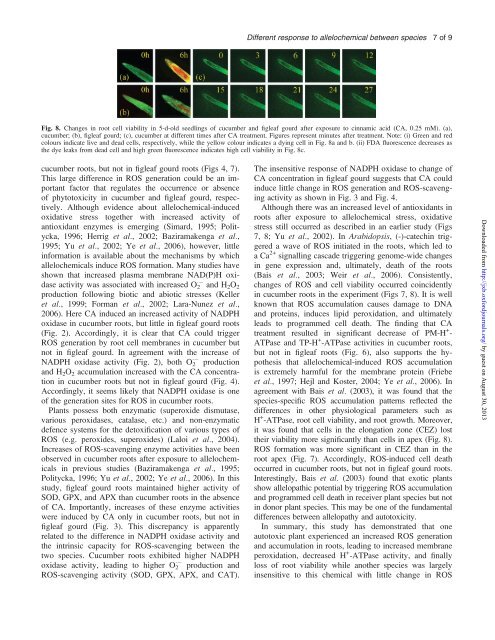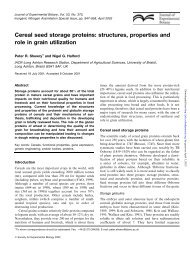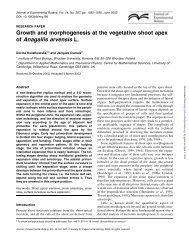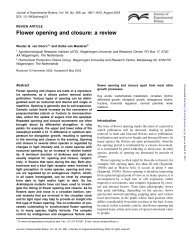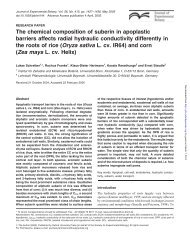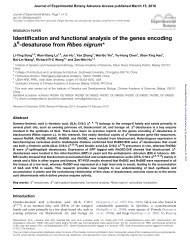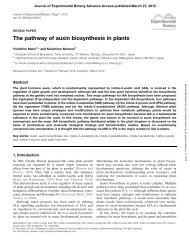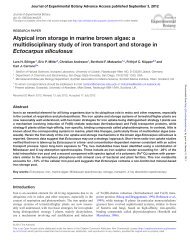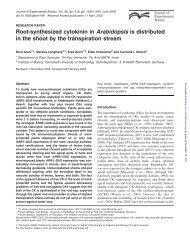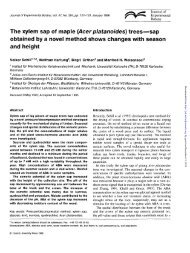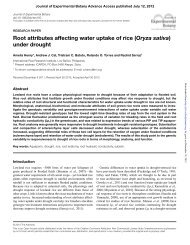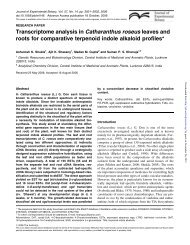Physiological basis of different allelopathic reactions of cucumber ...
Physiological basis of different allelopathic reactions of cucumber ...
Physiological basis of different allelopathic reactions of cucumber ...
You also want an ePaper? Increase the reach of your titles
YUMPU automatically turns print PDFs into web optimized ePapers that Google loves.
Different response to allelochemical between species<br />
7<strong>of</strong>9<br />
Fig. 8. Changes in root cell viability in 5-d-old seedlings <strong>of</strong> <strong>cucumber</strong> and figleaf gourd after exposure to cinnamic acid (CA, 0.25 mM). (a),<br />
<strong>cucumber</strong>; (b), figleaf gourd; (c), <strong>cucumber</strong> at <strong>different</strong> times after CA treatment. Figures represent minutes after treatment. Note: (i) Green and red<br />
colours indicate live and dead cells, respectively, while the yellow colour indicates a dying cell in Fig. 8a and b. (ii) FDA fluorescence decreases as<br />
the dye leaks from dead cell and high green fluorescence indicates high cell viability in Fig. 8c.<br />
<strong>cucumber</strong> roots, but not in figleaf gourd roots (Figs 4, 7).<br />
This large difference in ROS generation could be an important<br />
factor that regulates the occurrence or absence<br />
<strong>of</strong> phytotoxicity in <strong>cucumber</strong> and figleaf gourd, respectively.<br />
Although evidence about allelochemical-induced<br />
oxidative stress together with increased activity <strong>of</strong><br />
antioxidant enzymes is emerging (Simard, 1995; Politycka,<br />
1996; Herrig et al., 2002; Baziramakenga et al.,<br />
1995; Yu et al., 2002; Ye et al., 2006), however, little<br />
information is available about the mechanisms by which<br />
allelochemicals induce ROS formation. Many studies have<br />
shown that increased plasma membrane NAD(P)H oxidase<br />
activity was associated with increased O 2 and H 2 O 2<br />
<br />
production following biotic and abiotic stresses (Keller<br />
et al., 1999; Forman et al., 2002; Lara-Nunez et al.,<br />
2006). Here CA induced an increased activity <strong>of</strong> NADPH<br />
oxidase in <strong>cucumber</strong> roots, but little in figleaf gourd roots<br />
(Fig. 2). Accordingly, it is clear that CA could trigger<br />
ROS generation by root cell membranes in <strong>cucumber</strong> but<br />
not in figleaf gourd. In agreement with the increase <strong>of</strong><br />
<br />
NADPH oxidase activity (Fig. 2), both O 2 production<br />
and H 2 O 2 accumulation increased with the CA concentration<br />
in <strong>cucumber</strong> roots but not in figleaf gourd (Fig. 4).<br />
Accordingly, it seems likely that NADPH oxidase is one<br />
<strong>of</strong> the generation sites for ROS in <strong>cucumber</strong> roots.<br />
Plants possess both enzymatic (superoxide dismutase,<br />
various peroxidases, catalase, etc.) and non-enzymatic<br />
defence systems for the detoxification <strong>of</strong> various types <strong>of</strong><br />
ROS (e.g. peroxides, superoxides) (Laloi et al., 2004).<br />
Increases <strong>of</strong> ROS-scavenging enzyme activities have been<br />
observed in <strong>cucumber</strong> roots after exposure to allelochemicals<br />
in previous studies (Baziramakenga et al., 1995;<br />
Politycka, 1996; Yu et al., 2002; Ye et al., 2006). In this<br />
study, figleaf gourd roots maintained higher activity <strong>of</strong><br />
SOD, GPX, and APX than <strong>cucumber</strong> roots in the absence<br />
<strong>of</strong> CA. Importantly, increases <strong>of</strong> these enzyme activities<br />
were induced by CA only in <strong>cucumber</strong> roots, but not in<br />
figleaf gourd (Fig. 3). This discrepancy is apparently<br />
related to the difference in NADPH oxidase activity and<br />
the intrinsic capacity for ROS-scavenging between the<br />
two species. Cucumber roots exhibited higher NADPH<br />
<br />
oxidase activity, leading to higher O 2 production and<br />
ROS-scavenging activity (SOD, GPX, APX, and CAT).<br />
The insensitive response <strong>of</strong> NADPH oxidase to change <strong>of</strong><br />
CA concentration in figleaf gourd suggests that CA could<br />
induce little change in ROS generation and ROS-scavenging<br />
activity as shown in Fig. 3 and Fig. 4.<br />
Although there was an increased level <strong>of</strong> antioxidants in<br />
roots after exposure to allelochemical stress, oxidative<br />
stress still occurred as described in an earlier study (Figs<br />
7, 8; Yu et al., 2002). In Arabidopsis, (-)-catechin triggered<br />
a wave <strong>of</strong> ROS initiated in the roots, which led to<br />
aCa 2+ signalling cascade triggering genome-wide changes<br />
in gene expression and, ultimately, death <strong>of</strong> the roots<br />
(Bais et al., 2003; Weir et al., 2006). Consistently,<br />
changes <strong>of</strong> ROS and cell viability occurred coincidently<br />
in <strong>cucumber</strong> roots in the experiment (Figs 7, 8). It is well<br />
known that ROS accumulation causes damage to DNA<br />
and proteins, induces lipid peroxidation, and ultimately<br />
leads to programmed cell death. The finding that CA<br />
treatment resulted in significant decrease <strong>of</strong> PM-H + -<br />
ATPase and TP-H + -ATPase activities in <strong>cucumber</strong> roots,<br />
but not in figleaf roots (Fig. 6), also supports the hypothesis<br />
that allelochemical-induced ROS accumulation<br />
is extremely harmful for the membrane protein (Friebe<br />
et al., 1997; Hejl and Koster, 2004; Ye et al., 2006). In<br />
agreement with Bais et al. (2003), it was found that the<br />
species-specific ROS accumulation patterns reflected the<br />
differences in other physiological parameters such as<br />
H + -ATPase, root cell viability, and root growth. Moreover,<br />
it was found that cells in the elongation zone (CEZ) lost<br />
their viability more significantly than cells in apex (Fig. 8).<br />
ROS formation was more significant in CEZ than in the<br />
root apex (Fig. 7). Accordingly, ROS-induced cell death<br />
occurred in <strong>cucumber</strong> roots, but not in figleaf gourd roots.<br />
Interestingly, Bais et al. (2003) found that exotic plants<br />
show <strong>allelopathic</strong> potential by triggering ROS accumulation<br />
and programmed cell death in receiver plant species but not<br />
in donor plant species. This may be one <strong>of</strong> the fundamental<br />
differences between allelopathy and autotoxicity.<br />
In summary, this study has demonstrated that one<br />
autotoxic plant experienced an increased ROS generation<br />
and accumulation in roots, leading to increased membrane<br />
peroxidation, decreased H + -ATPase activity, and finally<br />
loss <strong>of</strong> root viability while another species was largely<br />
insensitive to this chemical with little change in ROS<br />
Downloaded from http://jxb.oxfordjournals.org/ by guest on August 30, 2013


